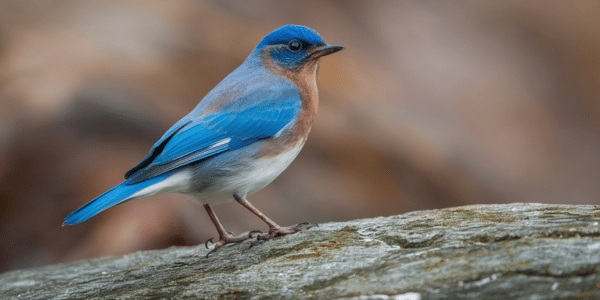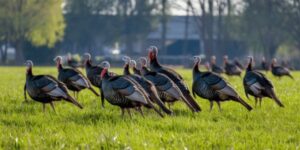The Mountain Bluebird, known scientifically as Sialia currucoides, is a remarkable species native to North America. This bird has always captured the attention of ornithologists and avian enthusiasts for its bright sky-blue feathers and beautiful song. In this complete guide, we will cover the Mountain Bluebird’s taxonomy, identification, behavior, habitats, migration patterns, breeding habits, diet, and conservation status. We want to provide you with an extensive resource that helps you understand and appreciate this amazing species better.
Taxonomy And Classification
Mountain Bluebirds belong to the order Passeriformes, which forms the largest order of birds, encompassing over 6,500 perching birds and songbirds. Within this order are found members of the family Turdidae, which includes thrushes distinguished by melodious songs and ground-feeding behavior. The genus Sialia encompasses all North American bluebirds, such as the Eastern Bluebird (Sialia sialis) or Western Bluebird (Sialia mexicana).
Scientific Classification
• Order: Passeriformes
• Family: Turdidae
• Genus: Sialia
• Species: Sialia currucoides
This classification within a larger group speaks to its common evolutionary history with other thrushes that have plump bodies and powerful legs equipped for feeding on the ground.
You May Also Like: What Happens When a Blue Jay Loses Its Mate

Identification Of Mountain Bluebirds
To identify a Mountain Bluebird, one needs to pay attention to specific physical characteristics and behaviors. This section offers a detailed guide on how to spot one in nature.
Size And Shape
A typical size range for a mountain bluebird is 6–7 inches long, with its wingspan ranging between 11-14 inches, making it slightly bigger than a sparrow but smaller than a robin. It has a short, dark graphitic bill that complements its aerodynamic and streamlined shape.
Color Pattern
• Males: This sex is distinguishable by the bright sky-blue color of their plumage. The lower breast and underparts show a light powder blue that fades to white, while the tips of the wings and tail feathers deepen into a rich royal blue.
• Females: They are drab in appearance with greyish brown upperparts and grey or creamy white underparts. Their wings, tails, and sometimes nape have a faint bluish tinge. A small white ring around the eye distinguishes them from other thrushes.
• Juveniles: Juveniles look like females but have a duller shade of gray on their bodies. However, young males eventually develop deeper blue and pale brown feathering.
Behavioural Traits
Mountain Bluebirds often nest near humans in yards within their distribution range. They hover over insects, then swoop down from perches to catch prey in flight. Males, particularly during the breeding season, exhibit territoriality by engaging in aggressive behavior, such as diving at what they perceive to be threats, including people coming close to their nests.
Mountain Bluebird Overview
| Category | Details |
|---|---|
| Scientific Name | Sialia currucoides |
| Common Name | Mountain Bluebird |
| Size | Length: 6.3–7.9 inches, Wingspan: 11.0–14.2 inches |
| Coloration | Males: Bright sky-blue; Females: Grayish-blue with faint blue on wings and tail |
| Habitat | Open areas such as grasslands, prairies, meadows, and alpine regions |
| Diet | Primarily insects (beetles, caterpillars, grasshoppers); fruits and berries in winter |
| Range | Breeding: Rocky Mountains, western Canada, Alaska; Winter: Southern U.S., Mexico |
| Nesting | Cavity nesters; prefer natural cavities or nest boxes in open areas |
| Breeding Season | Early spring to early summer (late March to early July) |
| Vocalizations | Soft warbling song; “chewk” call used in flight or as an alarm |
| Conservation Status | Not endangered, but populations affected by habitat loss and competition for nesting sites |
| Threats | Habitat loss, pesticide use, competition with other species like European Starlings |
| Migration | Migratory; moves to lower elevations or southern regions in winter |
Habitat And Distribution
The Mountain Bluebird thrives in various open habitats throughout Western North America, where it can easily survive. Its preferred environments include mountainous grasslands, shrublands, coniferous forests, and tundras. These birds also live in more temperate regions and drier regions during different parts of the year.
Geographic Range
• Year-round Presence: California, Nevada, Utah, Arizona, Colorado
• Migration: During winter months, mountain bluebirds move downwards following juniper-rich woodland as well as plains and grassland, which stretches across the southern United States, even reaching central Mexico. By summer, they migrate northward, even up to Alaska
Preferred habitats
Mountain Bluebirds are most commonly seen in open areas and expanses where they can minimize obstruction. They breed at places of higher elevation, clearings within forests, or even rural backyards with low vegetation with enough room for searching for food.
You May Also Like: 20+ Colorful Backyard Birds in Michigan

Migration Patterns Of Mountain Bluebirds
Among the bluebird species, Mountain Bluebirds are the most migratory. Their movements depend upon the prevailing availability of food and suitable nesting sites.
Migration Cycles
• Autumn Migration: From late fall to early spring, flocks of Mountain Bluebirds, sometimes as many as 200 birds, migrate together. These migrations often head downhill towards warmer climates, where sustenance is more plentiful during cold seasons.
• Spring Migration: In early spring, these birds return to the upper regions to breed. They usually mix with other bluebirds, sparrows, and juncos when they migrate.
Breeding and Nesting Habits
During this period (April-September), Mountain Bluebirds are monogamous and form strong pair bonds.
Nesting Behavior
• Nesting Sites: Mountain Bluebirds prefer nesting in natural cavities in trees, such as old woodpecker nest holes or birdhouses made by people and nailed about three feet up on a tree trunk. Such nests can be found on cliffs, buildings, or in open areas far from many human activities.
• Mimicry in Nest Building: Interestingly, males pretend to collect nesting material but do not pick anything up at all. The female then builds the real nest using grass stems, twigs, and pine needles, which hold it together as she lines it with fine grasses or animal fur/feathers.
• Egg Laying and Incubation: Four-eight pale blue eggs are produced by females, one per day. While the male feeds her, she incubates them for 13-17 days before hatching begins.
Post-hatching Care
Both parents feed and protect young birds, but males mostly feed chicks during the first days of hatching. The fledgling period lasts 17 to 23 days, and after that, the young birds continue to depend on their parents for another three weeks to two months.
Diet and Feeding
Mountain bluebirds are omnivorous, and what they eat depends on the time of year.
Summer Diet
During the breeding season and warm months, Mountain Bluebirds eat mainly insects such as beetles, crickets, spiders, ants, bees, and caterpillars. They hover near the ground and then dive into prey like falcons.
Winter Diet
As winter approaches, mountain bluebirds gradually change their food habits from insects to seeds, berries, and fruits. During this period, they select juniper berries, mistletoe, and hackberries for nutrients.
Conservation Status and Threats
The population size of Mountain Bluebirds fluctuated over time, decreasing heavily between 1966 and 2015.
Current Population Estimates
According to a survey conducted by the North American Breeding Bird Survey, the global population of mountain bluebirds is estimated at approximately 4.6 million. Nevertheless, its decline over several decades stands at 24%, so it is not listed as an endangered species today.
Conservation Efforts
Efforts are being made to conserve Mountain Bluebirds by reducing pesticide application, which affects their ability to reproduce. The construction of nest boxes in appropriate areas has also helped stabilize populations. However, continued monitoring and research are necessary for the long-term survival of these birds.
Predators and Lifespan
Predators of the Mountain Bluebird include raptors like Cooper’s hawks, peregrine falcons, and great-horned owls, as well as nest raiders such as raccoons and rodents. Typically, a mountain bluebird lives for six to ten years, with its highest mortality in the first year.
You May Also Like: Powerful Tips on Choosing Bird Bath Colors

Attracting Mountain Bluebirds to Your Backyard
To bring Mountain Bluebirds into your yard, you must create an inviting habitat that resembles their preferred natural environment.
Nesting Boxes and Habitat
• Placement: Ensure you put up nesting boxes far from any building in an open area in a rural setting. Such boxes should be placed at least 100 yards apart and have predator guards to prevent other animals from eating eggs or chicks.
• Vegetation: Planting junipers and maintaining low shrubs can enhance the attractiveness of your yard. Having moving water can also attract them more strongly.
How You Can Help
By participating in nest box programs, creating bird-friendly habitats in your garden, supporting organizations dedicated to wildlife conservation, and reporting sightings to local birding groups or citizen science projects that monitor population trends and help develop conservation strategies, you will have contributed to conserving mountain bluebird populations.
Conclusion About Mountain Bluebirds
The Mountain Bluebird is an amazing species that represents the beauty and resilience of North American avian fauna. From its striking plumage to complex behaviors, this bird has continually fascinated bird watchers and researchers alike. Understanding its needs while supporting conservation efforts will ensure the survival of this bird for generations ahead.
FAQs About Mountain Bluebirds
What do Mountain Bluebirds eat?
Mountain bluebirds are mainly insectivorous, feeding on beetles, caterpillars, grasshoppers, and other small insects during normal weather conditions, but fruits during winter when insects are scarce.
Where can I find Mountain Bluebirds?
Typically, they are found in open areas such as grasslands, meadows, and prairies. These birds breed in high-altitude regions of the Rocky Mountains, Western Canada, and Alaska. In winter, they migrate to lower elevations in the southern USA and Mexico.
How can I attract Mountain Bluebirds to my yard?
To lure them into your garden, you set up nest boxes for cavity-nesting birds; place the boxes in open spaces with a few trees. This is particularly important during winter, when water sources become a vital attraction, especially because they feed on fruits.
What is the breeding season for Mountain Bluebirds?
Breeding begins in early spring with the onset of male mating displays, which last from late March to early July. During this time, male mountain bluebirds display colorful plumage while each establishes its territory by singing.
How can I help with the conservation of Mountain Bluebirds?
You can also take action by participating in nest box programs, creating bird-friendly habitats at home, reducing pesticide use, supporting conservation organizations, or reporting sightings to local birding groups and citizen science projects that monitor population trends. This will assist in designing suitable conservation strategies.
What are the main threats to Mountain Bluebirds?
The primary causes behind declining Mountain Bluebird populations include the destruction of their habitat by agriculture or urbanization, competition from other species, such as European Starlings, for nesting sites, and the effects of pesticides that kill insects useful for feeding young ones, in addition to directly affecting these birds themselves.
How can I tell the difference between a Mountain Bluebird and other bluebird species?
Mountain Bluebird males are recognized by their uniformly blue bodies, while females have light blue wings and tails. There is no reddish or orange coloration on the chest of Mountain Bluebirds, unlike Eastern and Western Bluebirds, which have it.
Do Mountain Bluebirds migrate?
Yes, they do migrate. In winter, the birds move to lower elevations or more southern regions and can be found throughout the southern United States, down to Mexico, before returning to summer in higher-elevated areas.
What kind of nest sites do Mountain Bluebirds prefer?
The mountain bluebird is an example of a cavity nester. It prefers natural cavities like those made by woodpeckers and artificial ones, too. The selection of sites is primarily based on the presence of minimal tree cover within open areas.
Are Mountain Bluebirds endangered?
Mountain Bluebirds are not currently listed as endangered species, but changes in habitat size due to human activities such as deforestation affect nesting places, among other things. They maintain healthy populations through conservation efforts that include programs for building nest boxes and preserving their habitats worldwide.












2 Responses